BIOS -
BIOS is an acronym that stands for Basic Input/Output System. It is meant to control your product at a very low level. As of right now there are three regularly used BIOS formats (there are actually more than that but there are three common ones). These are the AMI (American Megatrends Incorporated), Award, and Phoenix. When we first tinkered around with the Click BIOS from MSI we were not all that impressed. The BIOS had a cartoonish look and had some pretty bad lag when moving between screens. There were also functions that required the DVD or for additional software to be loaded onto your system drive (or to a USB drive). However with the second generation of MSI’s UEFI implementation much of that has gone away. Click BIOS II is very clean and easy to use. Check out our video walk through of the Click BIOS II on the X79A-GD65(8D).
 |
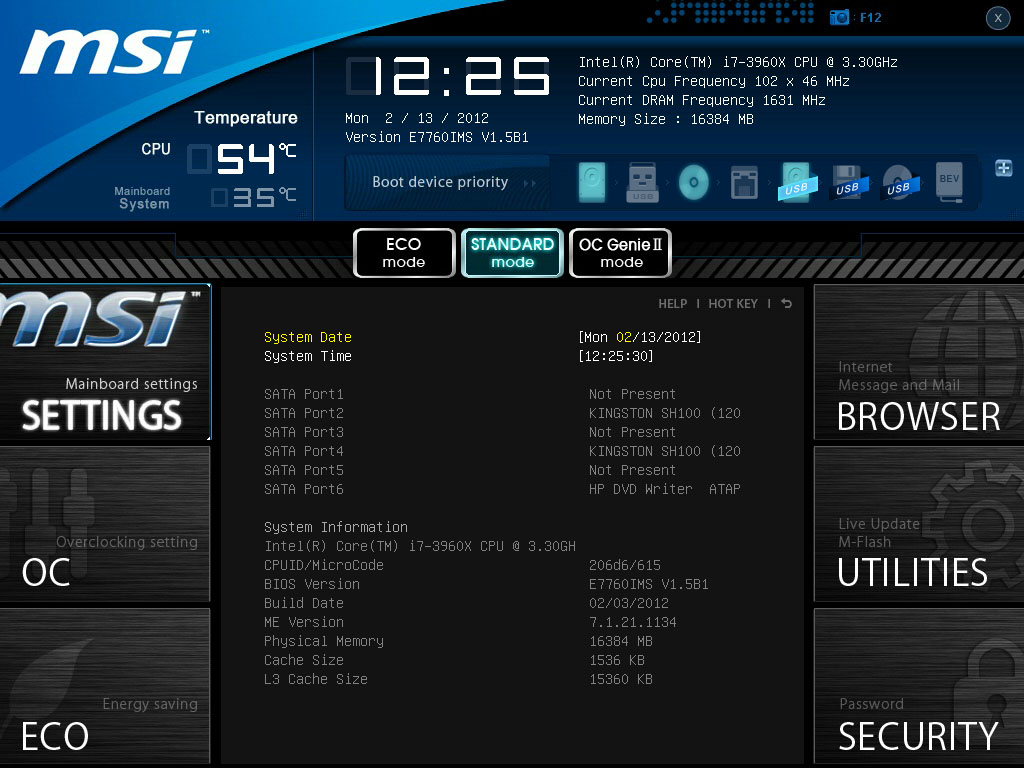 |
 |
 |
 |
Overclocking –
In the past we have had good luck with MSI and getting some good performance out of their products (at least for Motherboards). This was also the case with the X79A-GD65(8D). We did run into a couple of items that were unexpected though. For some reason we were not able to use the Boot Clock adjustment to kick the BCLCK up to 125MHz. Every time we tried it we hit a brick wall and the system would not post. This turned out to be ok as we were able to OC with a straight multiplier adjustment. We started off aiming for our current record of 4.7GHz on the Core i7 3960 we have in the lab. This did not end up working as we were unable to get to the login screen for Windows. At 46x100 we had no problems, but we wanted to try and push the system a little more. Using the same settings (as seen in the BIOS screen shots) we were able to get 4.691GHz (102MHz BCLK x 46 Multiplier) and run all of our tests without issue. This is not a bad overclock at all and although it did not break our max OC for the CPU we have we are confident that with more time you could get much more out of the MSI X79A-GD65(8D)
Of course overclocking is a picky subject. I can buy to identical CPUs from the store and they will not always perform the same way under stress. This is the same with motherboards, RAM and GPUs. So again it is important to keep in mind that our results represent a specific hardware configuration. Yours may be similar but will rarely be identical.
Overclocking Tool -
For MSI you actually have multiple tools you can use to overclock your system. The first, and one that MSI has been pushing for a while, is the OC Genie. This hand little tool allows you to perform a one button overclock. The overclock here is not going to give you world record performance, but it will give you a decent clock speed which in turn should give you a decent performance increase. You can also use the two step buttons on the board (the + and -) to increase or decrease the BCLK of your CPU dynamically; although I would not recommend using them to push too far.
If you are in Windows you have two additional tools to play with. The first is the TouchBIOS software that is a UI for interacting with the BIOS directly from inside Windows. This differs significantly from most overclocking software in that you have access to ALL BIOS features and not just the ones that cover clock speed and voltage.
Lastly you have MSI’s Control Center. This software is what you would expect from your traditional overclocking application. It also has an added benefit in that all of your options are on the one page for kicking your CPU into high gear.
 |
 |
 |
The Test System and Comments -
Our test system is built on an open bench. This has two effects on testing. First it allows us to see everything and also to setup and disassemble the test rigs quickly. Second it means that we cannot gauge the potential air flow found in a normal case. The air is pretty stagnant; some may say this is a great neutral testing method and it can be. However, it does mean that the temperature reading taken off of the components are not accurate to what an average consumer would see. This means that your thermal performance will vary from what we see here. 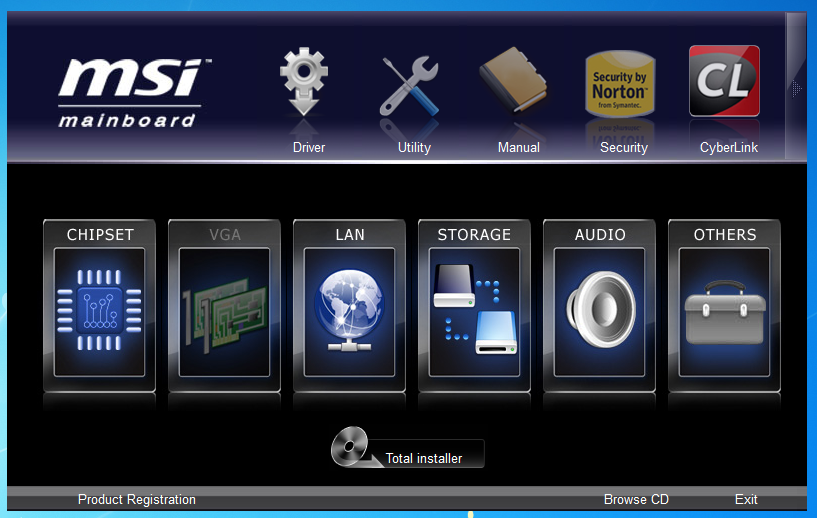
The X79A-GD65(8D) was pretty simple to setup. As with most boards you simply plug all your hardware in and go. For the most part this is how our installation went. We ran our Driver install and then installed the utilities that we wanted and started our testing. It was not until we hit 3PCMark7 that we began to see that something might be amiss. When we plugged in our hardware we used the PCIe Gen2 slot as our EAH5870 V2 is only Gen2 (makes sense). We found out quickly that this is a bad idea. If you use these (as both the manual and the naming convention would indicate) you will seriously hinder your GPUs performance.
After that was out of the way we took a look at some of the features that actually come with the X79A-GD65(8D). One of these is the SuperCharge for USB; this is a great feature that allows you to charge items like the iPad 2 and the iPhone 4 and 4S. It is not that big of a deal, but every little bit helps. 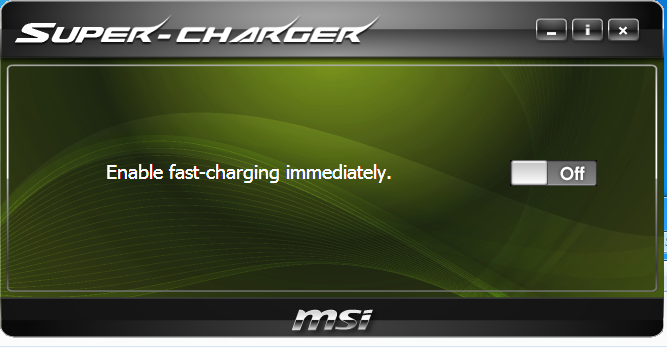
There really was not more to the feature set on the GD65 even though there was more software available on the install DVD.
 |
 |
Performance testing overview -
Our testing is a little different than most. We combine both synthetic and real-world applications to simulate the types of performance common to the individual products. For motherboards this means that we run roughly six synthetic tests and two real-world. We will be expanding the real-world testing in the near future. But there is more to performance than just the raw numbers. As there are multiple components and sub-components on a motherboard there each item can have a distinct impact on the way the product will perform once you get it in your system. It is important to note not only the actual results but what they mean to you as a potential consumer. We will try to give this information to you.
But we do not just cover the performance aspects that are measurable. We also talk about the components that might not have a direct benchmark. These are items like Audio Quality, ease of use and installation.
Section 1 Subsystems
Memory -
Memory performance is very important on a motherboard, especially when you have a CPU with multiple cores and threads. If you have slow memory your cores and threads can become starved for data to execute. To test memory performance we run both Sisoft’s SANDRA and AIDA64. These two combine to not only give us accurate numbers but to validate each other. For testing at stock speeds the memory is hard set to 1333MHz while overclocking testing is done at the highest stable speed for the voltage of 1.65v this is due to the different memory dividers for each CPU. As such, the memory speeds will vary greatly. This means that the overclocked numbers are a little misleading and while they can show a trend are really only included to show if a board has a problem with memory performance at high clockspeeds.
The MSI X79A-GD65(8D) did well in memory performance at stock speeds. It fell in right behind our lab leader for the X79 the Asus P9X79 Deluxe and tied with the Gigabyte G1.Assassin2. Once we overclocked the X79A-GD65 it fell a little behind.
AIDA64 fills in the gaps for memory performance on the X79A-GD65(8D).
| AIDA64 Stock Memory Performance | AIDA64 Overclocked Memory Performance |
 |
 |
Drive performance -
Drive performance is also one of the major subsystems that goes to make up the performance of a motherboard. For our testing we use Sandra and AIDA64 again. We only test with single drives for each type of controller present on the motherboard (unless it is a professional product where we will use RIAD 5 and/or 10). We have also begun using a Seagate PS-110 USB 3 external HDD for our USB 3.0 performance. As a side note, we include the overclocked numbers here to make sure (again) that you are not going to see a major drop in performance due to minor instabilities at high clock speeds.
Drive performance was a little different. As you can see we have put our new Kingston HyperX SATA 3.0 SSDs into play. We are using them for both SATA 2.0 and SATA 3.0 testing. Here you can see that while there is a dramatic difference in performance on the SATA 3 controller the SATA 2 controller does not show much. In fact the GD65 is behind some of our other X79 boards in this test.
Once again AIDA64 fills in the details for our HDD and USB 3.0 drive performance.
| AIDA64 Stock HDD Performance | AIDA64 Overclocked HDD Performance |
 |
 |
| ADIA64 Stock USB 3.0 Performance | AIDA64 Overclocked USB 3.0 Performance |
 |
 |
Power -
Power efficiency is another of those misnomers that we get caught up in. We hear about idle states and power gates. But what does that mean to you and I? On the surface having power management that reduces idle power sounds great and can be a benefit to someone that leaves their system on for long periods of time (and inactive) but how a system handles power under load and the delta between the two states is often more important than the idle power usage numbers. We use only P3 Kill A Watt instruments for measuring power. 
The power draw from the MSI X79A-GD65 was actually better than we expected. Under load it came in fourth place in out testing while running at stock speeds. When we pushed the system our power efficiency dropped a little more than we would have liked although an increase in power draw is expected when overclocking. 
Cooling (Board Level) -
Board level cooling is an important factor in product performance and longevity. Components like the chipset, VRM modules and even capacitors need to be kept relatively cool to prevent failure. As these parts are made of silicon, they have a thermal breakdown threshold; or melting point. At that temperature the actual transistors built into chip will begin to deform and break down. Granted, the threshold is often very high, but you still need to make sure that components stay away from this level of heat for longer product life. 
The cooling on the board was not as good as we would have liked. Under both stock and overclocked the MSI X79A-GD65 fell towards the bottom of our list. As we use water cooling and do not have any direct airflow over the PWM heat sink we are sure that once this board is in a case with good airflow you should not have too many issues with heat.
Audio -
Audio is highly subjective. What we find pleasing may sound “off” to you. That is always going to the problem with testing audio; results will vary too widely depending on the tastes of the listener. However, there are ways of measuring the audio output with an objective ear. There is also the issue of audio causing performance issues in gaming and video playback. The reason this is a potential source of concern is that all onboard audio CODECs (Compression/Decompression) are CPU controlled. This means that while the audio chip controls the audio levels and effects of the audio the actual work is done on the CPU. Usually this will not be a problem with today’s powerful CPUs. Even the lower and consumer level products can handle high-end audio these days. But again there is the chance that a bad design or software will hinder your system and performance. On the other side the limits of board space, cost, etc will also prevent the level of audio quality you can get from an add-in board. We test all audio parts with three media types, Movie (DVD), MP3 Music, and Gaming. These are pushed to our Tec On model 55 Tube Amp to see if we can detect any signal issues in the reproduction.
The Audio on the X79A-GD65 was not all that great. It was about what you would expect from a Realtek audio CODEC. It will suffice but is not going to wow you or bring any new life to your gaming.
Networking -
This one is something that is a requirement anymore. If you have a computer, the chances are good (like 99%) that you are also connected to high-speed internet. With this you need a good and solid LAN chip to make sure that your data flows properly out and back.
Oddly enough while the Audio CODEC is a Realtek ALC892 the LAN controller is not the typical Realtek (as it is listed on MIS’s website). Instead MSI has opted to drop an Intel 82579 Gigabit LAN controller onto this motherboard. We were a little impressed to find this and found that it was a nice improvement over the typical Realtek offerings.
Section II - Performance Tests,
Synthetic -
In this section of testing we cover the synthetics. These are tests that run a scripted sequence of internal APIs or that use another installed application to perform a series of scripted events. They are great in that they can provide reproducible results across various platforms. On the down side, synthetic tests can be fooled with driver tweaks and optimizations. In some cases it is necessary to rename the .exe file to something generic to discover if this is the case. In any event when this is needed (when a test shows a drastic difference in performance over the renamed exe) we will note this and show both results for comparison.
PCMark7 -
PCMark7 is the latest general performance test from FutureMark. As each generation of this benchmark has evolved and developed we have watched them add more and more realistic tests to this suite. With this generation we find more media tests, (audio and video transcoding) moving of large files, multiple web page rendering, and much more (the even added DX10 gaming). We use the Overall Performance and Common Usage suites in our testing.
The MSI X79A-GD65(8D) did not do so well in our PCMark 7 testing at stock speeds it only managed to best the AMD based 990FXA-UD5. Even when overclocked to 4.691GHz it still did not do as well as it should have. The prime suspect here is data transfer from HDD to Memory to CPU and back. Each one tests out properly on its own, but when they have to work together there is something that is slowing it all down. We also ran both the Gen2 and Gen 3 slots for video (at stock speeds) on this test.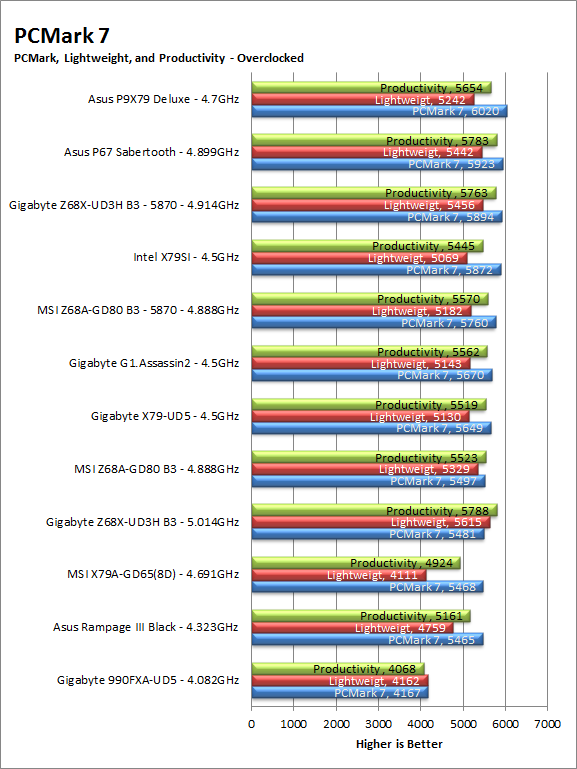
3DMark 11 -
3DMark 11 is the other Futuremark test that we run on our motherboards. This test simulates the typical tasks that a GPU (and system) would have to perform to provide you with a good gaming experience. It is based on the DX9, DX10 and DX11 engines but can only be installed on Windows Vista or later. The suite of tests covers DX9, DX10, and of course DX11 rendering; it also covers AI computations and physics. That’s right I said Physics the latest version of 3DMark uses a Havok physics engine. This removes the advantage that nVidia had with 3DMark Vantage. 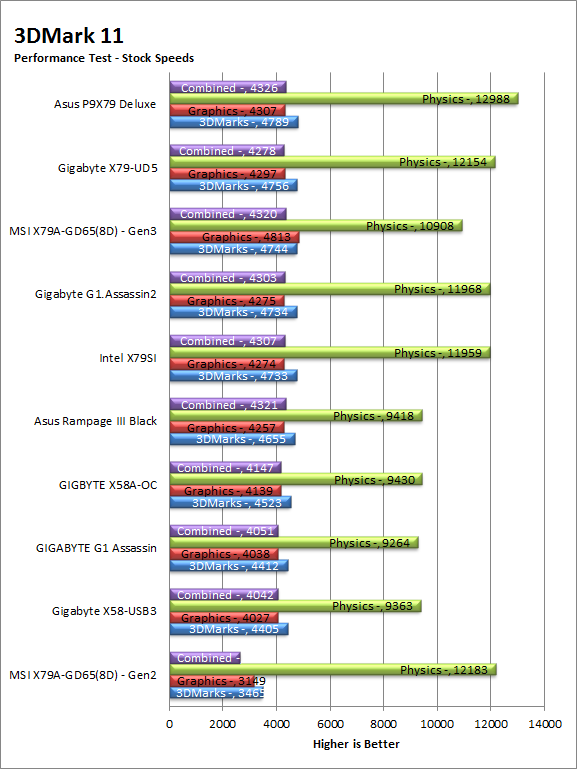
Here you can see just how drastic the difference in performance is when using the Gen2 slots. We were very surprised and disappointed about considering that Gen2 should not be that much slower and Gen 3 support was off in the BIOS. Surprisingly when overclocked the X79A-GD65(8D) pulled off a victory over the Asus P9X79 Deluxe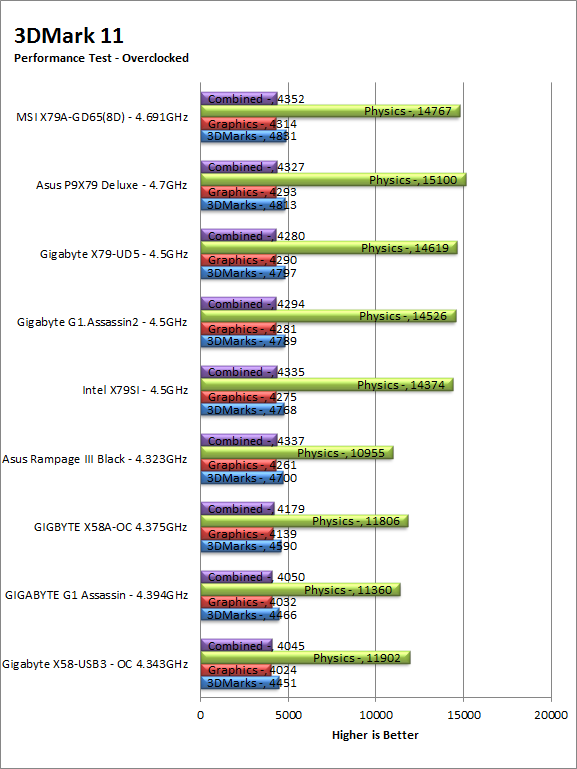
HyperPi 0.99b -
HyperPi is a front end application that allows you to easily run multiple instances of the SuperPi application. SuperPi, for those that are not familiar with it, is an application that measures the time it takes to calculate the number Pi out to as many as 32 million places. This calculation is then checked and run multiple times (up to 24 for a 32M run). This test stresses the CPU, Memory and HDD as data is handed off between the three. If there is a weak link, HyperPi will show it. For our testing we run the 32M test on as many cores (and threads) as the CPU has available. The slowest CPU time is then recorded. 
Here we see that HDD to mem to CPU issue again as the HyperPi times are not where they should be at stock or overclocked. We are hoping that this can be corrected with a BIOS update so there is still hope for the board.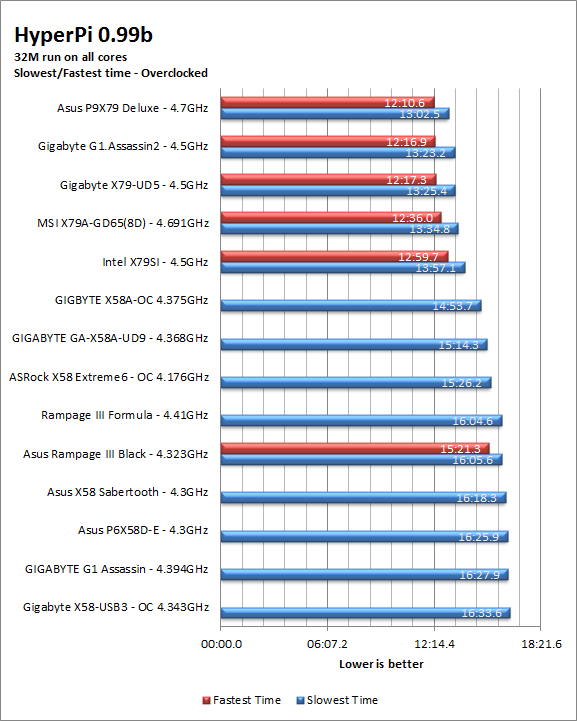
Cinebench R11.5 -
Cinebench R11.5 is the 11th release of Maxon’s rendering test. This test is based off of the Cinema 4D engine, which is one of the industry standard tools for digital animation. It is a powerful product with many different modules that can be “plugged” into it to increase its effectiveness. With Cinebench you get to see how your computer would do using this application. There are two tests; one tests the CPU’s ability to render an image across multiple cores or threads. The other tests your systems ability to handle OpenGL based rendering. 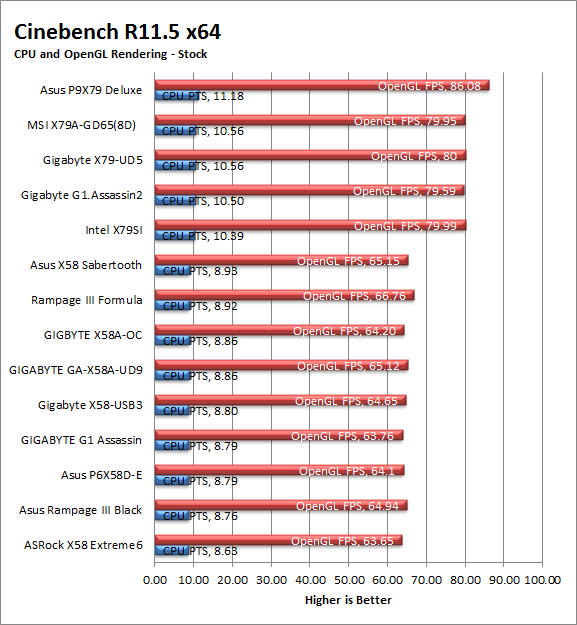
Interestingly enough in Cinebench things seem to drop back into line. Here we find the X79A-GD65(8D) right behind the Asus P9X79 Deluxe. This is a much better showing that our previous tests would have indicated.
Section III - Performance Tests,
Real-World -
Here we have two tests that are designed to put the performance of the motherboard and its subsystems to the test. Both require good CPU, Memory, HDD and even to a lesser extent audio and network performance. The two tests we chose were Lightwave 3D 9.6 and AutoGK 2.55. We will be adding at least one more real-world test to this battery in the near future, but for now these two cover quite a bit.
Lightwave 3D 9.6 x64 -
Lightwave is another industry standard application for 3D animation and rendering. It has a large tool base and the rendering engine is highly threaded (when using the right render model). This application is also capable of expanding to 4k resolutions as well as ray tracing for rending the light sources. For our testing we use frame 470 of the Pinball scene found in the LW 9 Content folder. This uses the newer perspective camera that is better suited to a multi-CPU/Core environment. This camera style also uses ray tracing and a much improved anti-aliasing method. Settings are shown below in the attached screen shot. Of course these are single frame renders and they are not a complete picture; for that you have to take into account the number of frames an average project would have. In a typical 30 second commercial you will have around 840 to 960 frames (at 28 – 32 FPS) this means that you have to multiply the time of a single frame by that number just to get a vague idea of how long that 30 seconds would take. This is because each frame will have a different render time based on complexity.
In Lightwave 3D the X79A-GD65(8D) does pretty good at stock speeds, it is very close to the performance of the other X79 boards we have tested although it is far behind the Asus P9X79 Deluxe here. At least it is until we overclocked the board at that point our Lightwave performance increased dramatically and the X79A-GD65(8D) managed another sub 5 minute 4K render.


CyberLink Media Espresso 6.5 -
After having various issues with AutoGK and Intel CPUs with more than four cores we have changed our Media Encoding test to use Media Espresso from CyberLink. Although this new utility does not have the same ability to transfer directly from DVD it is still a good test to transfer different media types into a usable format for your iPad, iPod, or other media player. Our test involves using multiple (Six) 20 minute media files and transcoding them for an iPad. This gives us a very good indication of how well a motherboard can handle this type of work load.
Our transcoding efforst appear to show the same performance issues that we ran into with HyperPI and also PCMark7. There is something that is happening here that is preventing the board from running at its full potential.
Section IV Performance – Gaming
Gaming as a test of motherboard performance is sort of a joke these days. The big player in the gaming arena is the GPU. Everyone but a few hardcore PR teams know this. However, it is important to run at least a few (one from each current DX version) to see if there are any issues with the combination of components on a motherboard. These are items like Audio lag, memory lag and of course problems with the PCIe lanes and signal traces. If there are issues in design, drivers or BIOS then you can have odd gaming performance. So without much more preamble let’s dive into the three games we currently use; Call of Duty Modern Warfare 2 for DX9 FarCry 2 for DX10 and Battlefield Bad Company 2 for DX11.
Call of Duty Modern Warfare 2 DX9 -
This is an excellent but short game that put you right into the action from the beginning and does not let up the pressure until the very end. The graphics are a little better; most notably the night and thermal imaging have been improved. The AI is still the typical COD “bar fight” style AI, with maybe a tad more finesse. All in all it is not a bad game to play and a decent one to use for testing. Our testing run starts at the bridge and ends after you clear the school in the first level of the game. Settings are shown below as are the performance numbers.
 |
 |

Here the MSI X79A-GD65(8D) came in around the lower middle section of our performance test group. This was slightly disappointing as we would have expected more. Still with a low FPS of 85 (and better performance than the G1.Assassin2) what is there to complain about?
FarCry2 DX10 -
Although not one of my favorite games this tedious game does have some good graphics. The large sandbox style of the game lends to mission based play. The only problem is that the AI is rather low grade. Still the more CPU power the more the bad guys try to do. Over all the game was a little bit of a disappointment to play, but still not a bad DX10 representation. Our testing run starts right after you get your first mission to clean out the safe-house and ends after the hostage rescue. Settings and performance numbers are shown below.

FarCry2 was also not that good as far as standings go. Again looking at the differences and what the actual frame rates are, you would not have a bad gaming experience.
Battlefield Bad Company2 DX11 –
I have liked many of the Battlefield games. They usually tend to be fast paced and fun. With Battlefield Bad Company 2 you do get some of that, but there is something about the graphics and the movement that just does not sit right. The AI is a less sophisticated form of the bar fight AI, but it gets the job done. Still, the game is good for testing as it can put a strain on the components of the board. Out testing run is the entire first level, from beginning to end. Settings are shown below along with the raw numbers.

Bad Company 2 is pretty much the same story until the board was overclocked. At that point the X79A-GD65(8D) picked things up.
Gaming wrap-up -
Although the numbers here show the performance as less than it should be it is important to remind you that the X79A-GD65(8D) still offers a good gaming experience visually. You also will be getting great LAN performance which means (depending on your internet connection) your online gaming experience should be good as well. About the only downside was the audio; we really wish it had been better. However the audio came out a little flat to our ears. It was not bad, but it really could have been better.
Value -
Value is another very subjective topic. What is expensive to some might be a deal to others. You can look at this topic in multiple ways. One is raw price and the other is what you get for the money. Each is accurate and both are correct ways to look at price/value. We tend to look at features, performance and real-property when we discuss value. However, we also take into account the raw cash cost of the item. The MSI X79A-GD65(8D) will run you about $290. This is a little less than your average X79 motherboard, but as it does not include the WiFi or Bluetooth adapter you would expect it to cost a little less (you can get boards with the WiFi/BT module for about $315). It looks like MSI offset the cost of the Intel LAN controller and some of the other higher-end components by removing this add-in. We do wish the performance was better as the performance that we see here does not really justify the full $290 price tag in our minds.
Conclusion -
Although the MSI X79A-GD65(8D) comes with Gen3 PCIe and some high-end components we were a little disappointed in it. There is something that is affecting performance when you need to move data between the memory, the HDD and the CPU. We saw this manifest in several tests. Our thoughts are that this is a BIOS issue and one that should be easily corrected. However, we have not ruled out the possibility that the PCIe Gen3 could be a factor. We saw some odd performance numbers when we tried to use the PCIe Gen2 slots so there could be something in the way the Gen3 switching is working that is causing an issue. Check out our final thought below;
Discuss this in our Forum

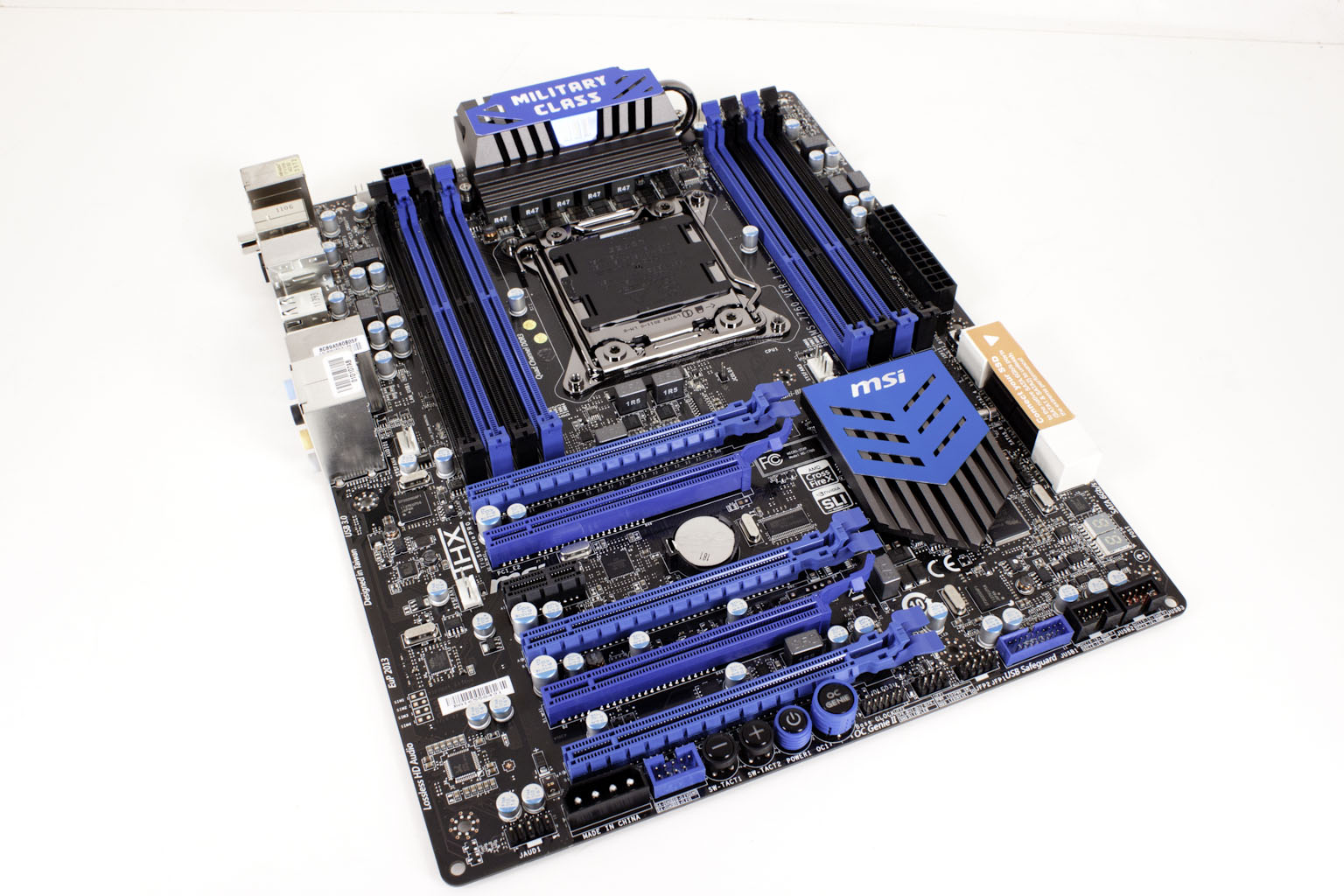 After taking a look over the MSI X79A-GD65(8D) motherboard and some of MSI’s design choices (and the benefits they bring) we have dove into our performance testing. You may remember that we had concerns about the way the PCIe slots were segmented into Gen3 and Gen2. To check and see what effect (if any) this might have on performance we ran some of our tests with the GPU in the Gen2 slot and some in the Gen3 slot. We were more than a little surprised at what we found out. So let’s get into the performance half of our review of the MSI X79A-GD65(8D) and see what we found.
After taking a look over the MSI X79A-GD65(8D) motherboard and some of MSI’s design choices (and the benefits they bring) we have dove into our performance testing. You may remember that we had concerns about the way the PCIe slots were segmented into Gen3 and Gen2. To check and see what effect (if any) this might have on performance we ran some of our tests with the GPU in the Gen2 slot and some in the Gen3 slot. We were more than a little surprised at what we found out. So let’s get into the performance half of our review of the MSI X79A-GD65(8D) and see what we found.

